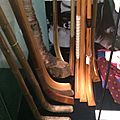Shinty facts for kids

A shinty game in progress
|
|
| Highest governing body | Camanachd Association |
|---|---|
| First played | Pre-historic Scotland and Ireland |
| Characteristics | |
| Contact | Full Contact |
| Team members | 12 players per side substitutes are permitted |
| Mixed-sex | Officially No (there are no rules to prevent women from playing in men's teams, but this happens frequently in the lower leagues, with some of shinty's elite female players playing or having played for lower league men's teams) |
| Equipment | Shinty ball |
Shinty is an exciting team sport played with sticks and a ball. In Scottish Gaelic, it's called camanachd or iomain. Today, shinty is mostly played in the Scottish Highlands. You can also find it played by people from the Highlands who have moved to bigger cities in Scotland. Long ago, shinty was played in many more places across Scotland. It was even played in northern England and other parts of the world where Scottish people settled.
How Shinty is Played
Many people compare shinty to field hockey, but there are some big differences. In shinty, players can hit the ball while it's in the air. They can also use both sides of their stick, which is called a caman. The caman is made of wood and has slanted sides.
Players use the caman to block shots and to tackle opponents. However, you are not allowed to hit an opponent's stick downwards. This move is called "hacking" and it is against the rules. Players can also tackle each other using their bodies, as long as it's shoulder-to-shoulder.
Shinty's History and Relatives
Shinty comes from the same ancient roots as other stick-and-ball games. One of these is hurling, which is played in Ireland. Another is bando, a game once played in Wales. Over time, shinty developed its own special rules and features.
The rules for shinty are set by the Camanachd Association. This group helps organize the sport. There's even a special game called composite rules shinty–hurling. This allows teams from Scotland and Ireland to play against each other every year.
Another sport that shares a common history with shinty is bandy. Bandy is played on ice. In fact, in Scottish Gaelic, the name for bandy means "ice shinty" (camanachd-deighe). A long time ago, the words "bandy" and "shinty" were sometimes used to mean the same thing in English.
Images for kids
See also
 In Spanish: Shinty para niños
In Spanish: Shinty para niños







